The Silent Killer: Diseases and Pests Behind Forest Tree Deaths
Why Are Our Forests Dying? Unraveling Non-Fire Related Tree Deaths
Reading time : 1 minute,
Discovery Chepe Id-791-ECO
Published in
07-21-2025

Photo: Uwe Conrad
The alarming disappearance of trees in jungles and forests is not always linked to the roaring flames of wildfires. In many green lungs of the planet, trees are dying silently, standing and intact, but lifeless. What is triggering this phenomenon that seems to go unnoticed by many?
Climate change: a silent but relentless killer
Climate change is playing a crucial role in the weakening of forests. The rise in global temperatures is altering rainfall patterns, generating longer droughts and unpredictable weather. Even in rainforests like the Amazon, severe droughts cause water stress, weakening trees to the point of collapse. This condition reduces their capacity to photosynthesize, defend against pests, and regenerate naturally.
Pests and diseases: invaders thriving in a warmer world
With a warmer and drier climate, pests and pathogens are flourishing. Insects like bark beetles and fungi that attack tree trunks find ideal conditions to multiply and devastate entire forest patches. Once a tree is weakened, it becomes the perfect victim, accelerating the spread of these invisible killers.
Fragmentation of forests: a dangerous isolation
The construction of roads, deforestation, and agricultural expansion have fragmented forests into small, isolated areas. This isolation interrupts natural processes like the flow of nutrients and the movement of pollinators and animal species that contribute to the ecosystem's balance. The soil degrades, and many trees die slowly from lack of essential resources.

The Growing Crisis of Tree Mortality: What's Harming Our Woodlands?
Photo: Adarsh Kummur
The cascade mortality effect
When large trees die, the ecosystem suffers a chain reaction:
1- Shade decreases, exposing the forest floor to more sunlight and higher temperatures.
2- The microclimate changes, affecting humidity and soil composition.
3- Younger trees and plants face harsher conditions, leading to more deaths.
This cycle is transforming lush jungles into vulnerable patches, susceptible to further degradation.
The paradox of CO2: fast growth, early death
Elevated carbon dioxide levels might seem beneficial because they accelerate tree growth. However, this rapid growth often comes at a cost: shorter lifespans. Trees that grow too fast tend to age and die earlier, reducing the forest's long-term resilience.
Scientific concern and ongoing research
Experts around the world are studying this alarming trend. According to a National Geographic report, tree mortality rates are rising globally, threatening biodiversity and the planet's ability to absorb carbon emissions.
What can be done?
a) Strengthening conservation policies to protect and reconnect fragmented forests.
b) Promoting reforestation with diverse native species.
c) Reducing greenhouse gas emissions to slow down climate change.
d) Supporting scientific research to better understand and combat emerging pests and diseases.
Conclusion
The death of trees in jungles and forests, without the presence of fire, is a wake-up call. It reflects the deep imbalance we have caused in nature. If we do not act urgently, these silent deaths could lead to the collapse of vital ecosystems that sustain life on Earth.
For further insights on this topic, you can visit Scientific American where experts discuss the global tree mortality crisis.
See Also
Discovery Chepe
Most read...















